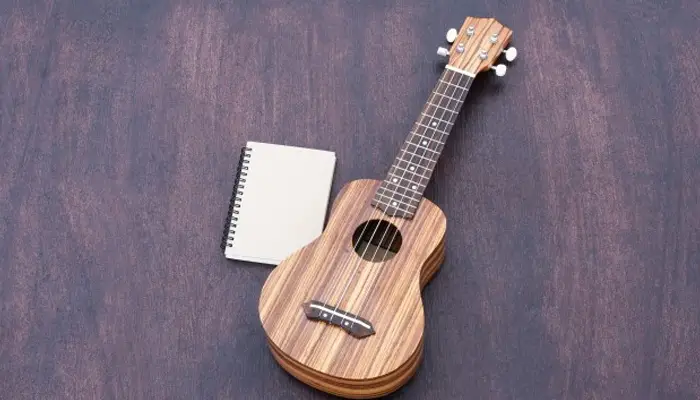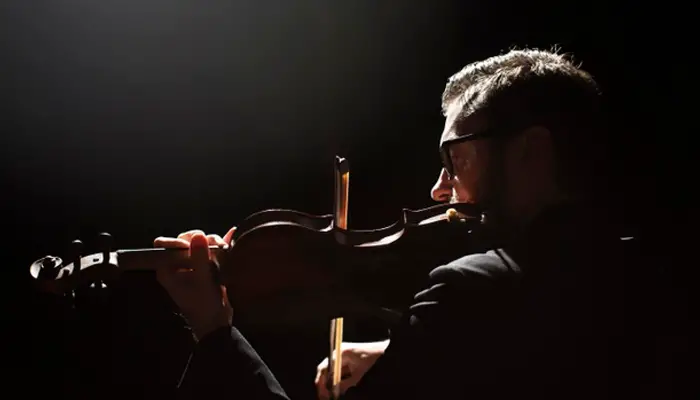
Do you find yourself creating a sing-song rhythm while playing the piano, or maybe strumming your guitar?
Maybe you’re just learning to play one of these instruments. Either way, if you are interested in learning more about musical instruments that start with G then read on!
This blog post will give an overview of 10+ musical instruments that start with G. It is sure to be informative and educational for any music lover.
Table of Contents
List of the Musical Instruments that Start with G
1. Gaita
Originating from Spain, the gaita is a traditional bagpipe with a distinctive sound, often featured in folk music. It typically consists of a leather bag, known as the “saco,” which acts as an air reservoir, connected to one or more chanters and drones.
The chanter usually plays the melody, while the drones provide a constant harmonic background. Gaitas vary in size, shape, and construction materials depending on the region and style of music. They are commonly associated with festivals, processions, and cultural events throughout Spain and other regions with Spanish influence.
2. Gandingan
Hailing from the Philippines, the gandingan is a set of hanging gongs used in indigenous music. Typically played in ensembles called “kulintang,” the gandingan produces rich, resonant tones that blend harmoniously with other instruments like the kulintang, agung, and dabakan.
Each gong in the set varies in size and pitch, allowing for intricate rhythmic patterns and melodic phrases. The gandingan holds cultural significance in various indigenous communities in the Philippines, where it accompanies rituals, celebrations, and social gatherings.
3. Gandingan a kayo
Similar to the gandingan, this instrument employs bamboo resonators to produce resonant tones. It consists of suspended bamboo tubes of varying lengths, with each tube producing a distinct pitch when struck.
The gandingan a kayo is commonly used alongside the gandingan in traditional Filipino music ensembles, adding depth and texture to the overall sound. Its earthy timbre and organic construction reflect the close relationship between music and nature in Filipino culture.
4. Gangsa
Another Filipino instrument, the gangsa consists of flat gongs played with beaters. These gongs are typically made of brass or bronze and are arranged in a row on a wooden frame. Each gangsa has a specific pitch, allowing for melodic and rhythmic interplay within the ensemble.
The gangsa is commonly played in traditional rituals, ceremonies, and social gatherings in the Philippines, serving as a means of cultural expression and community bonding.
5. Gayageum
A traditional Korean zither with silk strings, the gayageum produces melodious tones. It has a long, rectangular wooden body with movable bridges that determine the pitch of each string. The gayageum is played using a combination of plucking and finger techniques, allowing for dynamic expression and ornamentation.
It holds a central role in traditional Korean music genres such as court music, folk music, and contemporary compositions. The instrument’s elegant sound and intricate playing techniques reflect the depth of Korea’s musical heritage.
6. Güiro
Found in Latin American music, the güiro is a percussion instrument made from a hollow gourd with ridges. Players create sound by running a stick or scraper along the ridges, producing rhythmic patterns and accents.
The güiro is a versatile instrument used in various Latin American music styles, including salsa, merengue, and cumbia. Its distinctive sound adds texture and excitement to ensembles, making it a staple in both traditional and contemporary Latin music.
6. Gehu
A Chinese bowed instrument with a deep, resonant sound, the gehu is often used in traditional ensembles. Resembling a cello in appearance, the gehu has a wooden body with a soundboard, fingerboard, and one to two strings.
Players use a bow made of bamboo or synthetic materials to produce rich, expressive tones. The gehu plays a vital role in Chinese classical music, opera, and folk music, contributing to the ensemble’s harmonic foundation and melodic ornamentation.
8. Gendér
This Balinese metallophone produces shimmering tones and is integral to gamelan orchestras. Consisting of metal bars suspended over bamboo resonators, the gendér is played with mallets to create intricate melodies and interlocking patterns.
It is one of the core instruments in Balinese gamelan ensembles, where it provides a sparkling, ethereal sound that complements other instruments like the gongs, drums, and flutes. The gendér’s intricate tuning system and rhythmic precision showcase the virtuosity of Balinese musicianship.
9. Geomungo
A Korean fretted zither with six strings, the geomungo offers a rich, expressive timbre. Its long, curved body and silk strings allow for a wide range of dynamic and tonal possibilities. Players use a combination of plucking, strumming, and pressing techniques to produce fluid melodic lines and resonant chords.
The geomungo is a solo and ensemble instrument in traditional Korean music, revered for its ability to evoke a wide range of emotions and moods. Its deep cultural significance and technical complexity make it a cherished symbol of Korean musical heritage.
10. Gimbri
Originating from North Africa, the gimbri is a three-stringed bass instrument used in Gnawa music. Resembling a long-necked lute, the gimbri has a wooden body, a skin-covered resonator, and gut or nylon strings. Players use their fingers to pluck the strings while simultaneously tapping the body to create rhythmic accents.
The gimbri serves as both a melodic and rhythmic instrument in Gnawa music, providing a driving groove that underpins spiritual rituals and communal celebrations. Its deep, resonant sound and hypnotic rhythms have captivated audiences around the world, making it a beloved symbol of North African musical culture.
11. Gittern
An ancestor of the guitar, the gittern was popular in medieval Europe for its bright, twangy sound. It featured a pear-shaped body, fretted neck, and typically four or five strings. Played with a pick or fingers, the gittern was favored by troubadours and minstrels for accompanying songs and dances during the Middle Ages.
Its compact size and resonant tone made it a versatile instrument for both solo and ensemble performance, contributing to the vibrant musical culture of medieval Europe.
12. Glass Armonica
Invented by Benjamin Franklin, this instrument consists of glass bowls rotated by a spindle to create ethereal tones. Each glass bowl is tuned to a specific pitch, and the player wets their fingers with water to produce friction against the glass surface, generating hauntingly beautiful sounds.
The glass armonica gained popularity in the 18th century and was praised for its otherworldly timbre, believed to have therapeutic effects on the listener. Despite its brief period of prominence, the glass armonica remains a fascinating relic of musical innovation and experimentation.
13. Glass harp
Also known as the musical glasses, this instrument produces hauntingly beautiful sounds by rubbing moistened fingers along the rims of glassware. Each glass is filled with varying amounts of water to produce different pitches, allowing for a wide range of musical expression.
The glass harp has a long history dating back to the 18th century, with notable composers such as Mozart and Beethoven writing pieces specifically for the instrument. Its ethereal sound and visual appeal continue to captivate audiences worldwide, making it a unique addition to any musical ensemble.
14. Glasschord
A modern innovation, the glasschord combines the principles of the piano and glass harmonica to create a unique sound palette. It features glass bars similar to those found in a glass harmonica, arranged like keys on a piano keyboard.
Players press down on the glass bars to produce pitches, which are amplified through resonating chambers to create a rich, shimmering sound. The glasschord offers composers and performers a new avenue for sonic exploration, blending the crystalline purity of glass tones with the expressive capabilities of a keyboard instrument.
15. Glockenspiel
A percussion instrument similar to the xylophone, the glockenspiel features metal bars and produces bright, bell-like tones. The bars are arranged in a keyboard layout and struck with mallets to produce distinct pitches.
The glockenspiel is commonly used in orchestras, marching bands, and educational settings to add sparkle and clarity to musical arrangements. Its crisp, penetrating sound cuts through the ensemble, making it an essential component of both classical and contemporary music.
16. Gloggomobil
An experimental instrument, the gloggomobil consists of glass bowls mounted on a rotating platform, producing a mesmerizing sound when struck. Each glass bowl is tuned to a specific pitch, and as the platform rotates, the bowls come into contact with mallets or hammers, creating a cascading effect of harmonious tones.
The gloggomobil represents a fusion of acoustic and mechanical elements, offering a unique sonic experience that blurs the line between traditional and avant-garde musical instruments.
17. Gopuz
A traditional Central Asian instrument, the gopuz is a two-stringed lute with a pear-shaped body. It is carved from a single piece of wood and features a short neck, frets made of gut or nylon, and a resonating chamber covered with animal skin.
The gopuz is played with a plectrum or fingers and is known for its bright, resonant sound that carries across vast landscapes. It holds cultural significance in Central Asian music traditions, where it accompanies storytelling, dance, and festive celebrations.
18. Gottuvadhyam
A South Indian string instrument resembling the veena, the gottuvadhyam is known for its intricate fretwork and resonant sound. It has a long, hollow wooden body with a curved neck, frets, and typically seven strings. Players use a slide made of polished metal to change the pitch and add ornamentation to melodies.
The gottuvadhyam is a solo and ensemble instrument in Carnatic music, where it provides melodic and rhythmic accompaniment to vocal and instrumental performances.
19. Grand piano
A staple of classical and contemporary music, the grand piano boasts a wide range and dynamic expression. It features a horizontal frame with strings stretched over a soundboard, which is amplified through a complex system of hammers and dampers.
The grand piano offers unparalleled versatility, allowing pianists to explore a vast repertoire of musical styles and genres. Its rich, resonant sound and responsive touch make it a favorite instrument for concert halls, recording studios, and private homes around the world.
20. Great Highland Bagpipe
A symbol of Scottish culture, the great highland bagpipe is renowned for its stirring melodies and distinctive drone sound. It consists of a bag, blowpipe, chanter, and three drones: bass, tenor, and baritone.
The bagpipe is played by blowing air into the bag and squeezing it with the arm to maintain pressure, while the fingers of the other hand play the melody and control the drones. The great highland bagpipe is an iconic instrument associated with military regiments, ceremonial events, and traditional Scottish music, where it evokes a sense of pride, heritage, and camaraderie.
21. Guitar
One of the most popular instruments worldwide, the guitar comes in various shapes and sizes, offering endless possibilities for expression. It is a stringed instrument typically featuring six strings, although variations with fewer or more strings exist.
The guitar is played by plucking or strumming the strings with the fingers or a pick, and it is used in a wide range of musical genres, including rock, pop, blues, jazz, and classical music. With its versatility and portability, the guitar has become a staple instrument for musicians of all levels and styles, from beginners to professional performers.
22. Guitar synthesizer
A fusion of traditional guitar and electronic synthesizer technology, the guitar synthesizer opens up new sonic frontiers for musicians. It combines the familiar interface and playing technique of a guitar with the ability to produce a vast array of synthesized sounds, textures, and effects.
Using built-in synthesizer modules, guitar synthesizers can emulate various instruments, create atmospheric soundscapes, and manipulate audio in real-time. This innovative instrument expands the creative possibilities for guitarists, allowing them to explore electronic music genres, experiment with sound design, and push the boundaries of traditional guitar performance.
23. Guitarra quinta Huapanguera
A Mexican instrument with five double strings, the guitarra quinta huapanguera is essential to the son huasteco genre. It has a distinctively large body and a short neck, which contributes to its deep, resonant sound.
The guitarra quinta huapanguera is played with a unique strumming technique called “rasgueado,” where the fingers rapidly brush across the strings to create rhythmic patterns and accents.
It is a fundamental instrument in traditional Mexican folk music, particularly in the huapango and son huasteco styles, where it provides the rhythmic and harmonic foundation for vocal and instrumental ensembles.
24. Guitarrón
A large-bodied Mexican bass guitar, the guitarrón provides a deep, resonant foundation in mariachi music. It has a rounded back and a short neck, typically featuring six strings tuned to the pitches of EADGBE, but with the low E string an octave lower than a standard guitar.
The guitarrón is played with the fingers or a pick and is known for its rich, booming sound that complements the high-pitched melodies of violins and trumpets in mariachi ensembles. It serves as the backbone of the rhythmic groove, anchoring the harmonic structure and driving the energy of the music.
25. Guqin
A revered Chinese instrument with a history spanning thousands of years, the guqin is prized for its serene, meditative qualities. It has a long, rectangular wooden body with seven strings stretched across movable bridges. The guqin is played using the fingers of the right hand to pluck the strings while the left hand adjusts the pitch and adds ornamentation.
It is deeply rooted in Chinese philosophy, culture, and aesthetics, often associated with scholars, poets, and spiritual practitioners. The guqin repertoire includes a wide range of melodies, each with its own poetic title and symbolic meaning, reflecting the instrument’s profound connection to nature, meditation, and contemplation.
26. Gusli
A traditional Russian string instrument, the gusli features a shallow soundbox and delicate, shimmering tones. It has a flat, trapezoidal body with strings stretched across a wooden or metal frame. The gusli is played by plucking the strings with the fingers or using a small wooden stick called a plectrum.
It is known for its ethereal sound and expressive capabilities, often used in folk music, storytelling, and ceremonial rituals. The gusli holds a special place in Russian cultural heritage, symbolizing the beauty of nature, the resilience of the human spirit, and the enduring traditions of the Russian people.
27. Guzheng
Also known as the Chinese zither, the guzheng has a vast repertoire and a captivating, plucked sound. It features a long, rectangular wooden body with 21 or more strings stretched over movable bridges. The guzheng is played using the fingers of both hands to pluck the strings and create intricate melodies, harmonies, and rhythmic patterns.
It is a versatile instrument used in traditional Chinese music, ranging from classical compositions to contemporary arrangements. The guzheng’s expressive range, from delicate whispers to powerful flourishes, allows performers to convey a wide range of emotions and moods, making it a beloved instrument in Chinese culture.
Conclusion: Musical Instruments that Start with G
By exploring this diverse selection of musical instruments that start with the letter “G,” we’ve only scratched the surface of the rich tapestry of sounds found across cultures and traditions.
Whether you’re drawn to the haunting melodies of ancient Chinese instruments or the rhythmic pulse of Latin American percussion, there’s a world of musical exploration awaiting you.
Related Articles
- Musical Instruments that Start with A-Z (Exclusive Guide)
- 35+ Killer Musical Instruments that Start with B
- 55+ Best Musical Instruments that Start with C Letter
- Popular Musical Instruments that Start with D
- Top Musical Instruments that Start with E
- What’re the Musical Instruments that Start with K?
- What’re the Musical Instruments that Start with M?
- 50+ Best Musical Instruments that Start with S Letter
- What Is an Musical Instruments that Start with T?



